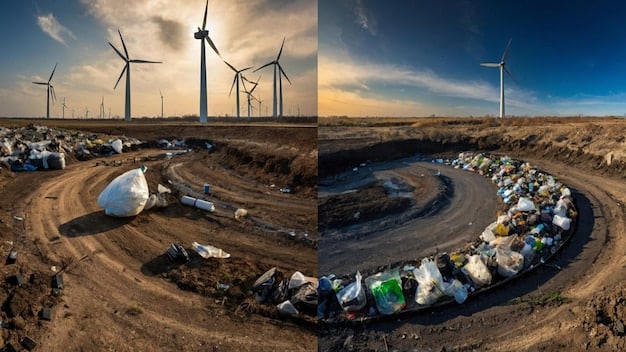Properly Recycle Electronics & Prevent E-Waste Pollution in 2025

Proper electronic recycling in 2025 involves understanding updated regulations, utilizing certified recycling centers, and adopting proactive measures to minimize e-waste’s environmental impact, ensuring a sustainable approach to technology disposal.
In an era defined by rapidly evolving technology, the question of what happens to our old gadgets looms large. As we approach 2025, understanding how to properly recycle electronics and prevent e-waste pollution becomes not just a good practice, but a necessity for a sustainable future.
Understanding the Growing E-Waste Problem
The proliferation of electronic devices has led to an exponential increase in electronic waste, commonly known as e-waste. This includes discarded computers, smartphones, televisions, and other electronic gadgets. Understanding the scale of this issue is the first step in addressing it effectively.
The Sheer Volume of E-Waste
E-waste is one of the fastest-growing waste streams worldwide. The amount of e-waste generated annually is staggering, and it continues to rise as technology becomes more accessible and devices have shorter lifespans.
The Toxic Components in Electronics
Many electronic devices contain hazardous materials such as lead, mercury, cadmium, and brominated flame retardants. When e-waste is not properly handled, these substances can leach into the soil and water, causing significant environmental damage and posing risks to human health.

- Environmental Impact: Improper disposal contaminates soil and water, harming ecosystems.
- Health Risks: Exposure to toxic materials can lead to serious health problems.
- Resource Depletion: Valuable materials are lost when not recycled, increasing the need for mining.
- Global Inequality: E-waste is often shipped to developing countries, causing environmental injustice.
Recognizing the environmental and health impacts of e-waste is crucial for motivating individuals and organizations to adopt responsible recycling practices. The future depends on our ability to manage e-waste effectively.
Updated E-Waste Regulations and Laws in 2025
E-waste management is governed by a complex web of regulations and laws that are constantly evolving. Staying informed about the latest updates is essential for ensuring compliance and promoting responsible recycling.
Federal Regulations in the US
In the United States, there is no comprehensive federal law specifically addressing e-waste. However, the Environmental Protection Agency (EPA) regulates certain aspects of e-waste management under the Resource Conservation and Recovery Act (RCRA).
State-Level E-Waste Laws
Many states have enacted their own e-waste laws, which vary in scope and requirements. These laws often include provisions for mandatory recycling programs, producer responsibility, and restrictions on the disposal of certain electronic devices in landfills.

Keeping abreast of the latest e-waste regulations and laws is imperative for individuals, businesses, and organizations to ensure compliance and promote responsible recycling practices. This helps to protect the environment and human health.
Finding Certified E-Waste Recycling Centers
One of the most critical steps in properly recycling electronics is to use certified e-waste recycling centers. These facilities adhere to strict standards for environmental protection and data security, ensuring that e-waste is handled responsibly.
The Importance of Certification
Certified e-waste recycling centers are audited by third-party organizations to ensure they meet specific standards for environmental performance, worker safety, and data security. This provides assurance that e-waste is being managed properly.
Common Certifications to Look For
There are several certifications for e-waste recycling centers, including R2 (Responsible Recycling), e-Stewards, and WEEE (Waste Electrical and Electronic Equipment). Each certification has its own set of standards and requirements.
- R2 Certification: Focuses on responsible recycling practices and data security.
- e-Stewards Certification: Emphasizes the ethical and environmentally sound management of e-waste.
- WEEE Compliance: Meets the requirements of the European Union’s WEEE Directive.
Choosing a certified e-waste recycling center is essential for ensuring that your electronics are recycled responsibly and that your data is protected. Look for facilities with reputable certifications and a proven track record of environmental stewardship.
Preparing Your Electronics for Recycling
Before taking your old electronics to a recycling center, there are several steps you can take to prepare them for recycling. This includes removing personal data, deleting accounts, and disassembling devices when possible.
Data Security Measures
Protecting your personal data is a critical concern when recycling electronics. Before handing over your devices, be sure to wipe the hard drives, delete accounts, and remove SIM cards and memory cards.
Physical Disassembly (When Possible)
In some cases, it may be possible to disassemble your electronic devices before recycling them. This can help to separate different materials and make the recycling process more efficient.
- Wipe Hard Drives: Use specialized software to securely erase data.
- Delete Accounts: Remove any personal accounts from the device.
- Remove SIM Cards: Physically remove SIM cards and memory cards.
- Check for Batteries: Remove batteries as they often require special handling.
Taking these steps to prepare your electronics for recycling can help to protect your personal data and ensure that valuable materials are recovered efficiently. Always prioritize data security and follow best practices for device disassembly.
Reducing E-Waste Through Responsible Consumption
The most effective way to address the e-waste problem is to reduce the amount of e-waste generated in the first place. This can be achieved through responsible consumption practices, such as buying durable products, repairing devices, and donating or reselling unwanted electronics.
Buying Durable and Repairable Products
One of the best ways to reduce e-waste is to buy electronic devices that are built to last and can be easily repaired. Look for products with good warranties and available replacement parts.
Repairing and Extending the Life of Electronics
Instead of replacing broken or outdated electronics, consider repairing them. Many common problems can be fixed with simple repairs, extending the lifespan of your devices.
- Choose Quality Products: Invest in durable electronics from reputable brands.
- Consider Refurbished Options: Buy certified refurbished devices to save money and reduce waste.
- Practice Mindful Consumption: Avoid unnecessary upgrades and replacements.
- Participate in Take-Back Programs: Utilize manufacturer programs to recycle old devices.
By adopting responsible consumption practices, you can significantly reduce the amount of e-waste generated and promote a more sustainable approach to technology. Every conscious choice makes a difference in minimizing environmental impact.
The Role of Technology in Improving E-Waste Recycling
Technological advancements are playing an increasingly important role in improving e-waste recycling processes. Innovations such as automated sorting systems, advanced material recovery techniques, and blockchain-based tracking systems are helping to make e-waste recycling more efficient and transparent.
Automated Sorting Systems
Automated sorting systems use advanced sensors and robotics to separate different types of materials in e-waste, such as metals, plastics, and glass. This increases the efficiency of the recycling process and reduces the need for manual labor.
Advanced Material Recovery Techniques
New techniques are being developed to recover valuable materials from e-waste, such as rare earth elements and precious metals. These techniques can help to reduce our reliance on mining and promote a circular economy.
Conclusion
- Innovate Recycling Processes: Support R&D into better sorting and recycling technologies.
- Invest in Infrastructure: Promote the development of advanced e-waste recycling facilities.
- Improve Material Recovery: Find new methods to extract valuable materials from e-waste.
- Enhance Transparency: Use blockchain to track and verify responsible e-waste management.
Technological advancements are transforming the e-waste recycling industry, making it more efficient, transparent, and sustainable. By embracing these innovations, we can minimize the environmental impact of e-waste and create a more circular economy for electronics.
| Key Point | Brief Description |
|---|---|
| ♻️ Regulations | Stay informed on updated e-waste laws to ensure proper handling. |
| 📍 Certified Centers | Use certified facilities (R2, e-Stewards) for responsible recycling. |
| 🛡️ Data Security | Wipe data, remove SIMs, and disassemble devices to protect your info. |
| 🌱 Consumption | Buy durable products, repair devices, and donate to reduce e-waste. |
FAQ
▼
E-waste includes discarded electronics like phones, computers, and TVs. They often contain toxic substances that can harm the environment and human health if not properly recycled.
▼
Check online databases and directories of certified recyclers. Look for certifications like R2 or e-Stewards to ensure responsible recycling practices are followed.
▼
Yes, absolutely. Wiping your data protects your personal information from being accessed by others. Use secure deletion methods before recycling any device.
▼
No, it is generally illegal and environmentally harmful to throw electronics in the trash. They should be recycled properly to prevent toxic materials from contaminating the environment.
▼
Many manufacturers offer take-back programs for their products, and they are also designing more durable and easily recyclable devices. Support companies that prioritize sustainability.
Conclusion
As we move closer to 2025, the responsible recycling of electronics is more critical than ever. By staying informed, taking proactive measures, and supporting sustainable practices, we can mitigate the harmful effects of e-waste and protect our planet for future generations.





